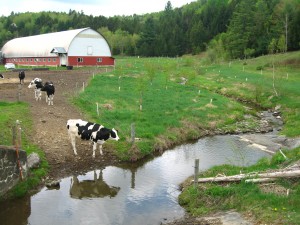
As part of the celebration of the 30th anniversary of the Conservation Reserve Program, FSA Administrator Val Dolcini recently visited the Hull’s dairy operation in Vermont to see conservation programs in action. The Hulls used a USDA conservation program to improve their operation and protect the Lake Champlain water basin.
Warren and Marie Hull, along with their sons Matt and Eric, know what it takes to produce high-quality milk while caring for the land on their Franklin County, Vermont, dairy farm. The Hulls have used many conservation practices and improvements on the farm over the years to protect the land and improve the water quality in the Lake Champlain water basin.
The Hull’s farm has been with the family for nearly 100 years. They currently milk 90 cows with another 80 dry cows or calves on the farm. Seven years ago, the Hulls enrolled more than 15 acres of pasture in the Conservation Reserve Enhancement Program (CREP), a U.S. Department of Agriculture (USDA) program in partnership with the Vermont Agency of Agriculture, Food and Markets.
CREP establishes partnerships and agreements with local conservation organizations and targets high-priority conservation issues identified at the local, state or regional level. Today, 1.2 million acres on more than 47,000 farms are under CREP contracts across the country.
Before enrolling in CREP, the laneways the cattle used on the Hull’s farm could get extremely muddy. The muddy paths were contributing to soil runoff into the streams. Additionally, the cows were forced to make direct contact with the stream for a water source which led to contamination of the stream, erosion of the stream bank and a loss of wildlife habitat.
The Hulls used the conservation program to plant trees and shrubs to convert these riparian areas to forested buffer zones, protecting and improving water quality in the nearly two miles of buffered stream.
They also installed 2.4 miles of fence and eight stream crossings. They installed a well, ran pipeline and added water tubs to provide additional water sources.
“By creating gravel-based laneways for the cows we reduced the mud running into nearby streams as well as kept the cows cleaner and enabled them to access pastures with ease,” said Matt. “This, in turn, allowed the cows to graze all areas of pasture, accessing water at each pasture, eliminating their direct access to streams.”

The Hull family used the USDA Conservation Reserve Enhancement Program (CREP) to fence off the stream and create stream crossings for livestock in order to keep the stream clean. They also created forested buffer zones that protect and improve water quality along two miles of buffered streams.
Recently, the Hulls used CREP simultaneously with the Farmer’s Watershed Alliance to install additional fence, two reinforced stream crossings and a reinforced/controlled water ramp to further protect the stream and associated wetlands. It keeps the herd out of streamside areas in the pasture.
CREP is part of USDA’s Conservation Reserve Program (CRP). This year marks the 30th anniversary of CRP, one of the largest private lands conservation programs that is helping to reduce soil erosion, improve water and air quality and provide better wildlife habitat.
To celebrate the 30th anniversary of CRP, FSA Administrator Val Dolcini visited the Hull family at Dalestead Farm in Enosburg to see the multi-practice CREP project first-hand and learn about conservation improvements on the dairy.
Because of their efforts, the Hulls’ farm was the recipient of the 2013 Lake Champlain Basin Program Farm of the Year for extraordinary conservation and stewardship efforts.
“After making these improvements, the cows are able to access fresh clean water without compromising the stream banks or the water quality in the streams,” said Matt. “And we have been able to increase the amount of land available for pasture because of the access to water tubs.”
Since being established on December 23, 1985, CRP has helped prevent more than 8 billion tons of soil from eroding and protected more than 170,000 stream miles with riparian and grass buffers, more than 100,000 acres of bottomland hardwood trees, nearly 300,000 acres of flood-plain wetlands, and 250,000 acres each for duck nesting habitat and upland bird habitat.
2015 marks the 30th Anniversary of CRP. For an interactive tour of CRP success stories from across the U.S., please visit the FSA CRP 30th Anniversary website at http://www.fsa.usda.gov/CRPis30.





